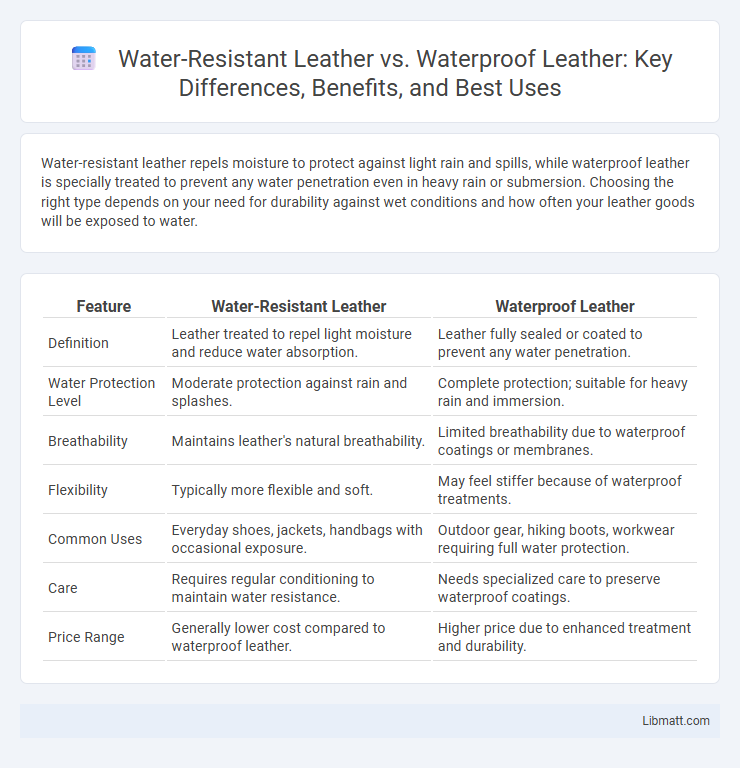Water-resistant leather repels moisture to protect against light rain and spills, while waterproof leather is specially treated to prevent any water penetration even in heavy rain or submersion. Choosing the right type depends on your need for durability against wet conditions and how often your leather goods will be exposed to water.
Table of Comparison
| Feature | Water-Resistant Leather | Waterproof Leather |
|---|---|---|
| Definition | Leather treated to repel light moisture and reduce water absorption. | Leather fully sealed or coated to prevent any water penetration. |
| Water Protection Level | Moderate protection against rain and splashes. | Complete protection; suitable for heavy rain and immersion. |
| Breathability | Maintains leather's natural breathability. | Limited breathability due to waterproof coatings or membranes. |
| Flexibility | Typically more flexible and soft. | May feel stiffer because of waterproof treatments. |
| Common Uses | Everyday shoes, jackets, handbags with occasional exposure. | Outdoor gear, hiking boots, workwear requiring full water protection. |
| Care | Requires regular conditioning to maintain water resistance. | Needs specialized care to preserve waterproof coatings. |
| Price Range | Generally lower cost compared to waterproof leather. | Higher price due to enhanced treatment and durability. |
Understanding Water-Resistant vs Waterproof Leather
Water-resistant leather is treated with a protective coating that repels light moisture, making it suitable for everyday wear and brief exposure to water. Waterproof leather undergoes advanced processing, sealing the material to prevent any water penetration, ideal for extreme wet conditions and prolonged exposure. Understanding these differences is crucial for selecting leather footwear or accessories that match specific environmental demands and durability requirements.
How Water-Resistant Leather Is Made
Water-resistant leather is treated with special oils, waxes, or synthetic coatings that create a barrier to repel water while preserving the leather's natural breathability. The tanning process often includes the application of hydrophobic agents that reduce moisture absorption without compromising flexibility and texture. Unlike waterproof leather, water-resistant leather offers moderate protection, making it suitable for everyday use in damp conditions but not for complete submersion or heavy rain exposure.
The Science Behind Waterproof Leather
Waterproof leather undergoes advanced chemical treatments and specialized coatings that create an impermeable barrier, preventing water molecules from penetrating the material. This science involves hydrophobic polymers and nanotechnology, which seal leather pores while retaining breathability and flexibility. Understanding these innovations helps you choose durable leather products that protect against moisture without compromising comfort.
Key Differences Between Water-Resistant and Waterproof Leather
Water-resistant leather features a protective coating that repels light moisture and prevents mild water damage, while waterproof leather is treated or constructed to block water penetration entirely, ensuring full protection even in heavy rain. Water-resistant leather maintains breathability and softness but offers limited defense against prolonged exposure to water, whereas waterproof leather often includes a membrane or dense tanning process to create a barrier that keeps water out while maintaining durability. Understanding these distinctions helps consumers select the appropriate leather type based on usage conditions and desired performance in wet environments.
Durability and Longevity: Which Lasts Longer?
Water-resistant leather is treated to repel water but can eventually absorb moisture, potentially compromising its durability over time. Waterproof leather undergoes a more intensive process, creating a solid barrier that prevents water penetration, ensuring greater longevity and protection in harsh conditions. Your choice should depend on the expected exposure; waterproof leather generally lasts longer due to its enhanced resistance to water damage and wear.
Best Uses for Water-Resistant Leather
Water-resistant leather is ideal for everyday items such as casual footwear, handbags, and jackets where light rain or occasional splashes occur. This type of leather is treated to withstand moisture and prevent damage but is not suitable for prolonged exposure to water or heavy rain. Water-resistant leather excels in urban settings and mild outdoor activities, offering a balance of durability and breathability.
Ideal Applications for Waterproof Leather
Waterproof leather is ideal for applications requiring complete protection from moisture, such as outdoor boots, hiking gear, and marine equipment, where exposure to heavy rain or water immersion is frequent. This type of leather undergoes specialized treatments or is combined with impermeable membranes to prevent water penetration entirely, ensuring durability and comfort in wet conditions. Your choice of waterproof leather ensures longevity and performance in environments where staying dry is critical.
Maintenance Tips for Each Type of Leather
Water-resistant leather requires regular cleaning with a damp cloth and periodic application of leather conditioners to maintain its protective barrier against moisture. Waterproof leather benefits from specialized waterproof sprays or wax treatments that enhance its resistance to water penetration, ensuring durability in wet conditions. Both types should be stored in a cool, dry environment and avoid prolonged exposure to direct sunlight to prevent cracking and discoloration.
Cost Comparison: Water-Resistant vs Waterproof Leather
Water-resistant leather typically costs less than waterproof leather due to the difference in treatment processes and materials used. Waterproof leather involves advanced coatings or membrane layers that create a complete barrier against water, increasing production expenses and retail prices. Your choice between water-resistant and waterproof leather should consider budget constraints alongside the level of water protection needed.
Choosing the Right Leather for Your Needs
Water-resistant leather repels water to a certain extent, suitable for everyday wear and light exposure, while waterproof leather is treated or constructed to prevent water penetration entirely, ideal for heavy rain or wet environments. Selecting the right leather depends on the activity level, desired durability, and exposure to moisture, with waterproof leather providing superior protection but often requiring more maintenance. Understanding the difference ensures you invest in leather goods that match your specific use case, whether for fashion, outdoor adventures, or work purposes.
Water-resistant leather vs waterproof leather Infographic

 libmatt.com
libmatt.com